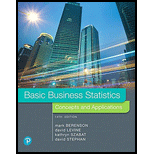
A freshly brewed shot of espresso has three distinct components: the hear, body, and crema. The separation of these three components typically lasts only 10 to 20 seconds. To use the espresso shot in making a latte, a cappuccino, or another drink, the shot must be poured into the beverage during the separation of the heart, body, and crema. If the shot is used after the separation occurs, the drink becomes excessively bitter and acidic, running the final drink. Thus, a longer separation time allows the drink-maker more time to pour the shot ensure that the beverage will meet expectations. An employee at a coffee shop hypothesized that the harder the espresso grounds were tamped down into the portafilter before brewing, the longer the separation time would be. An experiment using 24 observations was conducted to test this relationship. The independent variable Tamp measures the distance, in inches, between the espresso grounds and the top the portafilter (i.e., the harder the tamp, the greater the distance). The dependent variable Time is the number of seconds the hear, body and crema are separate (i.e., the amount of time after the shot is poured before it must be used for the customer’s beverage.) The data are stored in Espresso.
a. Use the latest-squares method to develop a simple regression equation with Time as the dependent variable.
b. Predict the separation time for a tamp distance of 0.50 inch.
c. Plot the residuals versus the time order of experimentation. Are there any noticeable patterns?
d. Compute the Durbin-Watson statistic. At the 0.05 level of significance, is there evidence of positive autocorrelation among the residuals?
e. Based on the results of (c) and (d), is there to question the validity of the model?
f. What conclusions can you reach concerning the effect of tamping on the time of separation?
Want to see the full answer?
Check out a sample textbook solution
Chapter 13 Solutions
Basic Business Statistics
- 2 Make a histogram from this data set of test scores: 72, 79, 81, 80, 63, 62, 89, 99, 50, 78, 87, 97, 55, 69, 97, 87, 88, 99, 76, 78, 65, 77, 88, 90, and 81. Would a pie chart be appropriate for this data? ganizing Quantitative Data: Charts and Graphs 45arrow_forward10 Meteorologists use computer models to predict when and where a hurricane will hit shore. Suppose they predict that hurricane Stat has a 20 percent chance of hitting the East Coast. a. On what info are the meteorologists basing this prediction? b. Why is this prediction harder to make than your chance of getting a head on your next coin toss? U anoiaarrow_forward6. Show that one cannot find independent, identically distributed random variables X and Y such that X-YE U(-1, 1). 7 Consider al onarrow_forward
- 2 Which situation is more likely to produce exactly 50 percent heads: flipping a coin 10 times or flipping a coin 10,000 times?arrow_forward2. Let X1, X2..... X, be independent random variables with expectation 0 and finite third moments. Show, with the aid of characteristic functions, that E(X₁ + X₂++X)³ = EX² + EX²++ EX₁₂-arrow_forward21 Check out the sales of a particular car across the United States over a 60-day period in the following figure. 800- 700- 600- Number of items sold 400 500- Line Graph of Sales 3001 16 12 18 24 30 36 42 48 54 60 60 Day a. Can you see a pattern to the sales of this car across this time period? b. What are the highest and lowest numbers of sales, and when did they occur? c. Can Can you estimate the average of all sales over this time period?arrow_forward
- 11 Bob has glued himself to a certain slot machine for four hours in a row now with his bucket of coins and a bad attitude. He doesn't want to leave because he feels the longer he plays, the better chance he has t win eventually. Is poor Bob right?arrow_forward7 You feel lucky again and buy a handful of instant lottery tickets. The last three tickets you open each win a dollar. Should you buy another ticket because you're "on a roll"?arrow_forward5 Suppose that an NBA player's free throw shooting percentage is 70 percent. a. Explain what this means as a probability. b. What's wrong with thinking that his chances of making his next free throw are 50-50 (because he either makes it or he doesn't)? 78 PART 2 Probability.arrow_forward
- A couple has conceived three girls so far with a fourth baby on the way. Do you predict the newborn will be a girl or a boy? Why?arrow_forward2 Suppose that you flip a coin four times, and it comes up heads each time. Does this outcome give you reason to believe that the coin isn't legitimate? dedo Raupnu stens My be sunildes ad ndaniver uoy no grin PALO STO 2010 COMO IT COUarrow_forward3 Consider tossing a fair coin 10 times and recording the number of heads that occur. a. How many possible outcomes would occur? b. What would be the probability of each of the outcomes? c. How many of the outcomes would have 1 head? What is the probability of 1 head in 10 flips? how d. How many of the outcomes would have o heads? What is the probability of o heads in 10 flips? e. What's the probability of getting 1 head or less on 10 flips of a fair coin?arrow_forward

 Holt Mcdougal Larson Pre-algebra: Student Edition...AlgebraISBN:9780547587776Author:HOLT MCDOUGALPublisher:HOLT MCDOUGAL
Holt Mcdougal Larson Pre-algebra: Student Edition...AlgebraISBN:9780547587776Author:HOLT MCDOUGALPublisher:HOLT MCDOUGAL

